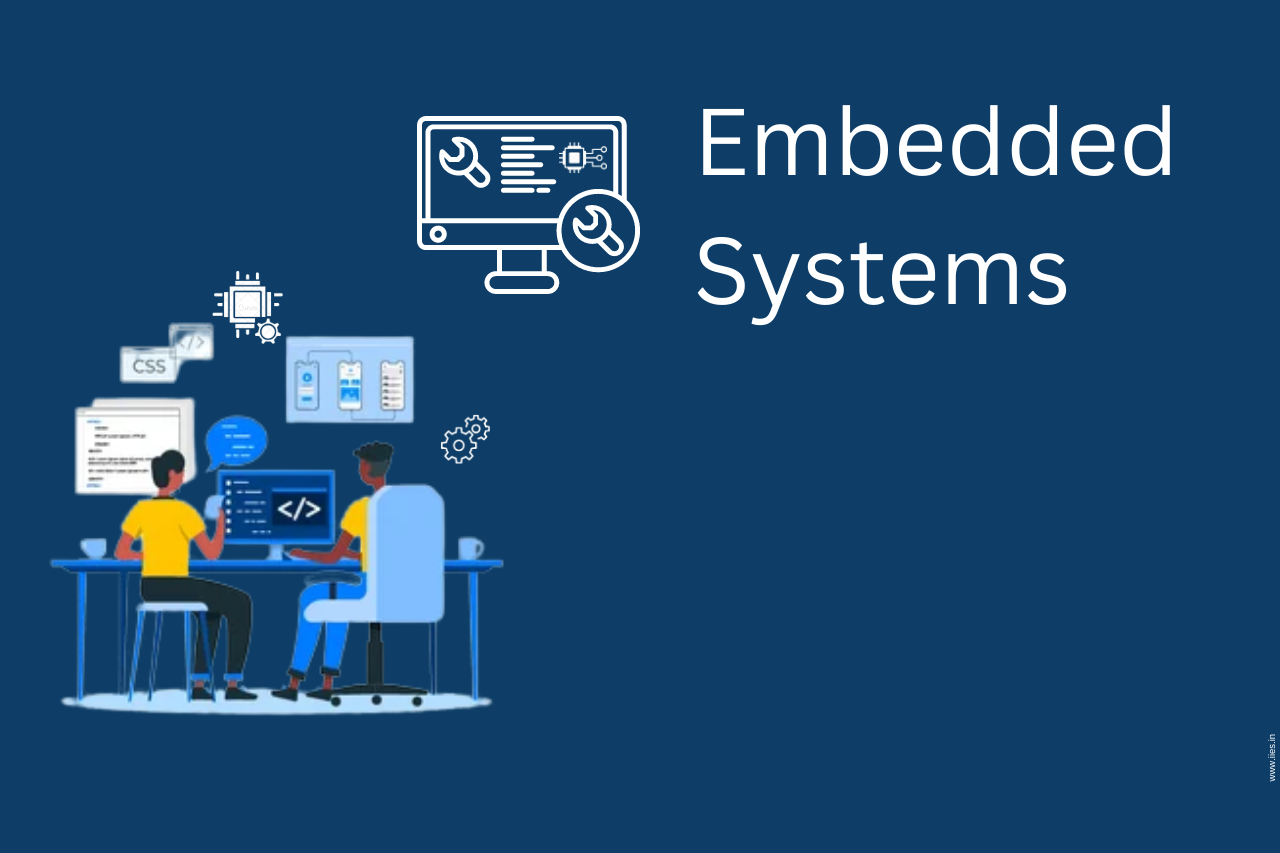An embedded system is a specialized computer system designed to perform a dedicated function within a larger mechanical or electrical system. It is built using a microcontroller or microprocessor, integrating both hardware and software to execute specific operations efficiently and reliably.
In today’s technology-driven world, embedded systems are everywhere — from smartphones and smartwatches to cars, washing machines, and medical devices. They play a vital role in automation, control, and smart connectivity across industries.
At IIES, our Embedded System Course has been designed to provide hands-on expertise and industry-relevant skills in Embedded Systems Design and Development. This program is part of the PG Diploma in Embedded Systems Design & Development, tailored for students and professionals seeking a future in embedded technologies and IoT.

Course Name: “Crash Course on Embedded System”
Duration – 20 Days
No. Of hours per day – 4 hours
Total No of hours – 80
Pre- and post-assessment – YES
Project – YES
Course completion certificate – YES
Pre-Requisite – Basic understanding of Computer Programming terminologies
The Crash Course on Embedded Systems offered by IIES delivers both theoretical knowledge and practical exposure. Participants are introduced to the essential principles of embedded design from hardware architecture to firmware programming.
Embedded systems are highly efficient, real-time computing systems responsible for controlling larger devices. They are known for their speed, reliability, compactness, and low power consumption. With the rise of IoT (Internet of Things), the importance of embedded systems has grown exponentially, as they enable smart connectivity and intelligent automation.
By joining this course, learners will gain valuable experience working on ARM-based microcontrollers, Embedded C programming, and real-world integration projects.
Upon completion of the Embedded System Course, learners will:
The course structure has been carefully designed to deliver strong technical and practical understanding:
Each topic is accompanied by practical labs and mini-projects to reinforce learning through hands-on experience.
Choosing IIES means gaining access to one of India’s most comprehensive and career-focused embedded systems training programs.
This program has been structured to help learners build practical knowledge, enhance technical problem-solving skills, and prepare for career-ready opportunities.
Graduates of the Embedded System Course can pursue diverse career paths across industries like automotive, telecom, aerospace, and consumer electronics.
Job Roles Include:
With increasing automation and IoT integration, demand for skilled embedded system engineers in India continues to rise.
Embedded systems are widely applied across sectors, including:
At IIES, learners gain exposure to real-world embedded applications, preparing them for both industrial and R&D roles.
Join the IIES Embedded System Course today and unlock your path toward a career in IoT, automation, and smart technology innovation.
An embedded system is a computer hardware and software combination designed for a specific purpose.
Embedded system are used to control a specific action within a device. Embedded systems are frequently designed to perform this activity repeatedly, while more powerful ones can control entire operating systems.
Processor
The processor serves as the system’s brain in any embedded system. The embedded system’s performance is determined by the CPU. There are many different types of processors on the market that users can choose from depending on their needs.
Embedded systems primarily use C language and assembly language. As well, Java and ADA are encouraged.
Learn an embedded programming language as the- 1 step.
Select an Embedded Computer in -Step 2
Setting Up Your Embedded Device -Step 3
Set up your IDE and tooling – Step 4
Test Your Embedded Project – Step 5
One of the main purposes for which embedded system are utilized is manufacturing automation. They make it feasible to automate and streamline the production process, and automation technology also helps to lower human error. to keep tabs on your output and energy resources.
Consumer, industrial, automotive, home appliance, medical, telecommunication, commercial, aerospace, and military sectors all frequently use embedded systems. Numerous embedded systems are used in telecommunications systems, from network telephone switches to end-user cell phones.
An embedded system often needs a variety of microprocessors, operating systems, and development tools. Each system must be tailored and altered to meet the requirements of the hardware that it manages and utilizes.
Qualifications for the Embedded Systems Engineering Diploma:
Candidates must have completed an engineering degree in IT, electronics, computer science, telecommunication, electrical, or instrumentation (10+2+4 or 10+3+3 years). Candidates may also hold an MSc/MS (10+2+3+2 years) degree in computer science, electronics, or information technology.
Advanced RISC Machine is the ARM acronym. It is the most widely used microcontroller programming in the field of digital embedded systems, and most organizations only use ARM microcontrollers since they have key characteristics that enable the development of goods with greater aesthetics.
The Components That Make Up Embedded Systems
A processor serves as the centre of an embedded system. On the basis of the input, it receives from various external devices, the central processing unit performs the required computation.
An embedded operating system (OS) is a specialized operating system designed to perform a specific function for a device that is not a computer. An embedded operating system’s primary function is to execute the code required for a device to function.
Pre-emptive operating system, real-time operating system , multi-tasking operating system, and operating system.
Rate Monotonic Operating System, Single System Control Loop, eCos, mbed OS, VxWorks, and Monotonic Operating System.
Indian Institute of Embedded Systems – IIES